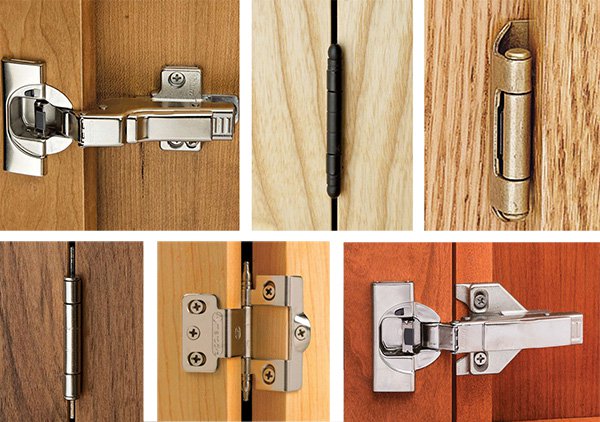
When it comes to cabinet hinges, you have many options to choose from. The type you need will depend on your cabinet design and door style.
A full overlay hinge covers the entire cabinet side or face frame, preventing gaps between the cabinet and door. It’s a popular option for European-style frameless cabinets.
Inset Concealed Hinges
The type of hinge you choose will make or break the overall look of your cabinet, door, or furniture. This is especially true for concealed hinges, which are more expensive than traditional hinges but offer a sleeker finish that is highly desirable in contemporary homes.
There are many different concealed hinges on the market, ranging in size, style, and finish. Your selection will depend on your cabinet door overlay style and frame or face-frame design. Frameless cabinets, popular in American households today, feature a face-frame hidden by the cabinet doors. These cabinets need a different hinge than framed cabinets because the doors cover the entire face-frame of the cabinet.
To accommodate full overlay cabinets, you will need a concealed hinge with a straight arm that can cover the entire edge of the side panel. Keahardware offers several different types of concealed hinges for this type of application, including our popular Euro-style hinges. These have a slightly longer arm that is offset significantly more than inset or partial overlay hinge styles and allow the cabinet door to completely cover the frame when closed.
When it comes to frameless cabinets or face-frame cabinets, you will need a concealed hinge with either a half or full overlay depending on your cabinet and door style. A full overlay hinge has a straight arm that allows the cabinet door to cover the side panel of the cabinet, while a half overlay hinge has a slightly blended arm that only covers half of the side panel.
Both a full and half overlay hinge requires accurate measurements and positioning to achieve a smooth fit. It is also important to note that most concealed hinge datasheets specify the mounting plate thickness, affecting the amount of overlay or reveal achieved.
Inset concealed hinges sit inside the frame of the cabinet and are often used with recessed or European-style doors. They have a small amount of play and are commonly found in frameless cabinets or framed face-frame cabinets. They have a large crank in the arm that helps set the door into the frame. This type of hinge is very similar to the full and half overlay option, but it requires more precise measurements and positioning to ensure the perfect fit.
Full Overlay Hinges
Full overlay hinges are ideal for furniture that requires a seamless look. They are perfect for cabinet doors that cover up the frame and face of a cabinet and are also suitable for furniture with a glass door. This type of hinge is often used on solid wood furniture. These hinges are very popular and offer a stylish look that is perfect for modern homes. These hinges are very functional and can help increase the storage space inside a cabinet.
Overlay hinges are available in a variety of different sizes and are commonly seen on furniture such as cupboards, cabinets, and other household furnishings. When choosing a size for your hinges, you will want to consider the thickness of your cabinet door, as well as the depth and reveal of the cabinet door itself. This will help to ensure that your cabinet door will fit properly on the hinges and will not leave a gap when closed.
The most common types of cabinet door hinges are either full overlay or inset, and both can be found in a range of finishes to suit any style. Full overlay hinges have a larger surface area than inset hinges, which means that they will overlap more of the cabinet door. They are a great option for homeowners looking to update their kitchen or bedroom with a modern aesthetic.
Half overlay hinges are similar to full overlay hinges in that they allow the door of a cabinet to partially or fully cover the face of the cabinet frame or panel when closed. However, half-overlay hinges do not overlap as much as their full-overlay counterparts, which can lead to some slight gaps when the cabinet doors are open.
Butterfly hinges are unique hinges that offer a decorative, sleek aesthetic. These hinges are characterized by having a frame wing that mounts to the exterior of the cabinet and a door wing that attaches to the front of the cabinet door. The two wings connect via a pivot point, called the knuckle, which is located on top of the hinge. The knuckle allows the door and the cabinet to rotate on the hinges, which provides additional movement and flexibility when opening the doors of a cabinet.
Half Overlay Hinges
Unlike the full overlay hinge, half overlay hinges only cover up half of the cabinet or face frame. They have a slightly blended arm to mount the door on either side of the panel. This gives the door a partial overlay on either side, resulting in the name “half overlay.” Companies manufacturing contemporary bedroom wardrobes typically use these types of hinges.
Overlay hinges are ideal for frameless cabinets because they leave a gap between the cabinet and the cabinet door, giving more storage space. They also provide a more seamless aesthetic to the cabinet doors than other types of hinges. However, they can be difficult to install because there is no space for error between the cabinet and the door, so measurements must be exact. This can be a challenge for some homeowners.
To determine the type of overlay a hinge offers, first look at the mounting plate to see what size screw holes drilled into it. If there are no markings, then check the back of the hinge to see if it has a label or if the manufacturer imprinted a code on it to identify the type of overlay that it supports. If the hinge is marked with a specific overlay, you can then purchase the correct hinge for your cabinet.
Aside from the type of overlay, the other important feature to consider is the degree of opening that a cabinet hinge offers. Many manufacturers offer a range of degrees, so you can choose the one that best fits your kitchen’s needs. For example, some of the most popular options include 110-degree and 270-degree full-overlay hinges.
Regardless of the type of cabinet hinge you select, you should ensure that it includes a soft-close feature to ensure that your cabinet doors close smoothly and silently. This will prevent any potential damage to the cabinet doors and will keep them from slamming shut too hard and causing a loud bang when you open or close them. In addition, a soft-close hinge will allow the door to close and stay open at an angle of your choice without requiring you to manually adjust it.
Semi-Concealed Hinges
A semi-concealed hinge is designed to allow a portion of the hinge to be visible while the rest of the hinge is hidden on the frame or door. This type of hinge is typically used on overlay doors.
There are many different types of concealed hinges on the market, and identifying which one you need can be difficult. To help you figure it out, look at the hinge’s mounting plate to see if any markings or logos are printed on it. This will give you a good idea of which type of concealed hinge and whether it is the right fit for your project.
Another way to determine which type of concealed hinge you need is by examining the hinge cup and measuring the overlay. You can do this by measuring from the edge of the hinge cup to the door frame or face frame. Once you have these measurements, you can choose the proper hinge size to ensure a seamless connection between your cabinet door and the frame or face frame.
While there are advantages and disadvantages to both the full overlay and half overlay hinge designs, it ultimately comes down to personal preference and the desired look of your cabinets. If you prefer a more seamless appearance, then a full overlay hinge is the right choice for you. However, a half overlay hinge is the better option if you like the traditional look of a gap between your cabinet door and the frame.
The type of hinge that you choose also depends on the style and thickness of your cabinet door. If you have a thicker door, then a sturdier full overlay hinge may be needed to support it. On the other hand, if you have a thinner door, then a lighter half overlay hinge may be sufficient.
When deciding which type of hinge to use, it’s important to ensure that the hinges you choose are high quality. This will ensure that they can withstand the weight of your cabinet door without any issues. Lastly, when choosing a hinge, be sure to select a model with a side adjustment feature. This will enable you to correctly regulate the gaps between your cabinet doors and cabinets and align them at the top and bottom.





